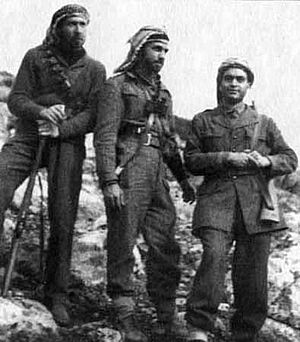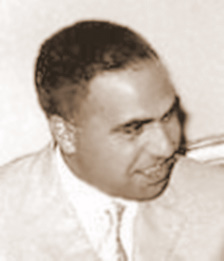Abdel Hamid al-Sarraj facts for kids
Quick facts for kids
Abdel Hamid Sarraj
|
|
|---|---|
|
عبد الحميد السراج
|
|

Sarraj in 1958
|
|
| Chairman of the Executive Council of the Northern Region of the United Arab Republic | |
| In office 20 September 1960 – 16 August 1961 |
|
| Prime Minister | Gamal Abdel Nasser |
| Preceded by | Nur al-Din Kahala |
| Succeeded by | Maamun al-Kuzbari |
| Personal details | |
| Born | September 1925 Hama, French Syria |
| Died | 23 September 2013 (aged 87–88) Cairo, Egypt |
| Occupation | Minister of Interior (1958–1961) Vice-president (1961) |
| Military service | |
| Rank | Colonel |
Abdel Hamid Sarraj (Arabic: عبد الحميد السراج, born September 1925 – died 23 September 2013) was a Syrian Army officer and a well-known politician. He played a very important role when Egypt and Syria joined together to form the United Arab Republic (UAR). Sarraj was a strong supporter of Egyptian president Gamal Abdel Nasser. People sometimes called him Sultan Abdel Hamid because he was known for being very strict.
Contents
His Early Life and Military Career

Abdel Hamid Sarraj was born in Hama, Syria, in September 1925. He came from a traditional Muslim family with Kurdish roots. He went to the Homs Military Academy, which was a military school. He became one of the first officers in the Syrian army after Syria gained its independence from France.
Sarraj also took part in the 1948 Arab-Israeli War. He volunteered for the Arab Liberation Army. During this war, he led a small group of six armored vehicles to surround the city of Safad.
Becoming a Leader
Sarraj was involved in a military takeover in 1949 that removed Husni al-Zaim from power. Later, in 1952, he took charge of the staff department for Adib Shishakli's government. When Shishakli was removed from power, Sarraj was sent to Paris for a short time to help with military matters.
However, in February 1954, he was chosen to lead Syria's military intelligence. This job allowed him to stop many plans against the government. Sarraj did not officially join any political parties. But he worked with the ruling parties, especially against the Ba'ath party. In September 1957, he helped arrange for 4,000 Egyptian soldiers to land in Latakia. This was part of a defense agreement between Syria and Egypt.
His Role in the United Arab Republic
When Egypt and Syria formed the United Arab Republic (UAR), Sarraj became a very important person. He was made the Minister of Interior. This meant he was in charge of internal security. His power grew even more on March 13, 1958. On that day, the Syrian police, desert patrol, and general security department all came under his control.
After some ministers from the Ba'ath party left the UAR government, Sarraj was given even more jobs. On January 1, 1960, he also became the Minister of Social Affairs and the Minister of Awqaf (religious endowments).
On September 20, 1960, Sarraj was appointed President of the Syrian Executive Council (SEC). At just 35 years old, he became the most powerful Syrian official in the UAR. Besides being the interior minister and president of the SEC, he also led the Syrian branch of Nasser's National Union party. He was also chairman of the Syrian economic foundation. A British official once called him the "Viceroy of Syria," meaning he was like a powerful ruler.
However, Sarraj was known for using strict police methods, which made him unpopular in Syria. Despite this, he was seen as a true Arab nationalist who could "get things done." Some people tried to convince Nasser to remove Sarraj from power. But Nasser refused, believing Sarraj was the best person to manage Syria for him. Finally, in August 1961, Nasser decided to make Sarraj a vice president. This meant Sarraj had to move to Cairo, which reduced his power in Syria.
On September 18, Nasser combined the two branches of the National Union. This took away Sarraj's position as Secretary-General of the Syrian branch. Also, Egyptian vice president Abdel Hakim Amer fired one of Sarraj's close friends. Because of these events, Sarraj resigned. An official tried to help Sarraj and Amer work things out, but it didn't succeed. Sarraj then started gathering his supporters. Realizing he couldn't go against Nasser, he agreed to meet Nasser and Amer in Cairo. Nasser criticized Sarraj for wanting too much power. However, Nasser did replace Amer as Minister of Syrian Affairs with Mahmoud Riad. Sarraj returned to his job as Syria's vice president and led a group working on UAR administrative changes. But he suddenly resigned again on September 26, and Nasser accepted it. Amer was sent to replace him.
Later Life and Passing
On September 28, 1961, a military takeover happened in Syria. This led to the end of the UAR. Sarraj was arrested and put in the Mezzeh Prison in Damascus. He managed to escape from prison and left Syria for Beirut, Lebanon.
In 1964, a group called the Syrian Socialist Nationalist Party (SSNP) tried to harm Sarraj. This made him flee to Egypt, where he made peace with Nasser. Sarraj lived in Cairo as a regular citizen and worked as a director of social security. In 2004, it was reported that he was still living in Cairo. There were efforts by former defense minister Mustafa Tlass to bring Sarraj back to Syria. According to a newspaper, he was expected to return in late 2005.
However, Sarraj did not return to Syria. He passed away in Cairo on September 23, 2013. He had wanted to be buried in Syria. But because of the unsafe conditions in Syria due to the civil war, he was buried in Cairo instead.
See also
 In Spanish: Abdel Hamid al-Sarraj para niños
In Spanish: Abdel Hamid al-Sarraj para niños



